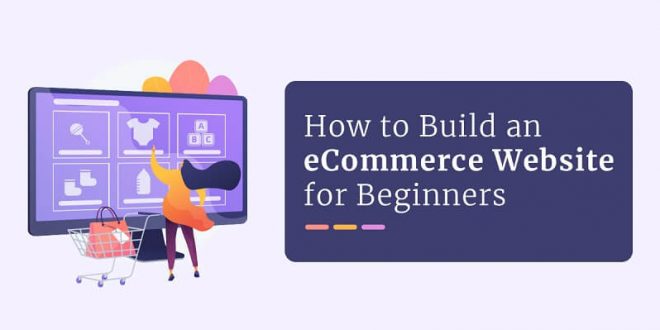Hello guys, today in this article, we are going to discuss the step-by-step guide for beginners to build an eCommerce website. So keep reading.
There’s an overwhelming statistic about Ecommerce usage by people, that’s 58.4% of internet users purchase something online every week. It increased online retail sales to $4.9 trillion globally. Every year, the eCommerce industry is reaching new milestones, which is gearing up for people with entrepreneurial mindsets or physical stores online.
E-commerce stores are merging with brick-and-mortar stores because revenue from online sales and offline sales are found to be nearly equal.
It makes perfect sense to get build a website and grow sales by leaps and bounds. However, building an eCommerce store from scratch is an expensive and time-consuming endeavor when one starts with development and marketing.
How To Build An eCommerce Website?
If you are one of those millions of users purchasing things online; you know how convenient and seamless to shop online. But building an eCommerce store that stays up to the customer expectations is not an easy deal. As a budding player, you need to do a lot of research, make decisions, and take action to build and let your online store prosper. It’s a step-by-step process that you should follow. Let’s dive in!
Choose The eCommerce and Hosting Platform
It’s the first step towards the E-commerce script development journey where you need to select the eCommerce script platform depending on the eCommerce business idea, functionalities, performance, traffic, and mobile responsiveness. Various eCommerce platforms such as Magento, Shopify, BigCommerce, WooCommerce, and others are available that facilitate a set of functionalities that businesses can easily customize to sync with their business needs.
E-commerce hosting means the place where data of your built eCommerce Website will be stored that directly impacts the data security and dollars. Cloud-hosting is considered the most secure and inexpensive option for eCommerce stores as they easily scale the space when business data increases.
On the flip side, on-premise hosting involves hosting the website on local servers that are taken care of by businesses. It requires infrastructure installation, maintenance, and personnel to take care of the server.
Buy A Domain
Stores when having a domain name, just need to transfer the domain name. The rookie players require to purchase the domain, they need to follow some practices before creating a domain name.
- Create a domain name that’s 6-14 characters long and easy to memorize. The short names are better for marketing that drives more customers to the store.
- Create a domain name, that’s unique and remind your target users about the brand whenever they see the name.
- Create a domain name that contains no numbers and hyphens as it makes the name difficult to pronounce. Keeping the name error-proof and easy to remember is ideal.
Select The eCommerce Developers
The Ecommerce development selection plays a critical role in bringing success to the business. The dedicated eCommerce developers can guarantee the Ecommerce development and launch within the defined timeline and set aside a budget.
When you narrow down the search for developers, you should interview the developers, and check their portfolio, expertise, experience, and communication skills so that the best team of developers, designers, testers, and marketers is selected.
Find A Theme That Matches With Business Vision
The eCommerce platforms provide many readymade templates that enable businesses to customize them according to their business vision and mission without requiring any technical knowledge. When a template is selected, make sure it provides seamless navigation that allows users to easily move back and forth from one page to another.
The customization options available for colors, fonts, product display, images, and social media enable integration of the functionalities that make the website design align with the brand. The possibility to add a brand story, slideshow, videos, and images on the homepage allows you to communicate the brand to users. You should check them fairly.
Upload Products
When you Build An eCommerce Website, importing and displaying products on Ecommerce uniquely is important to bring the products into the limelight. It requires a few things to keep in mind.
- Add the complete product description that showcases the product utility, color, measurement, and others; which enables search engine bots to index product pages. Ensure it contains short sentences for product details and target users while writing the product description.
- The product images help in visually appealing to the audience. The product images must be of high quality, every image has the same size and is taken from different angles that improve user engagement.
- Add product categories to allow users easily apply filters and get the things they are looking for.
Make Necessary Settings For The Payment, Tax, and Others
The users abandon the cart if they don’t get the favorable payment mode or if payment processing is too complex. Even, easy payment becomes essential during peak season for increased sales. Different types of payment gateways- redirects, checkout on-site and payment off-site, and on-site payments leveraged for the best results.
The redirect payment gateway type involves redirecting the user to a third-party site for payment processing and taking care of security. The on-site payment makes it the responsibility of the eCommerce store owner to take care of payment processing. The last option involves the users’ payment acceptance on the website and then details provided off-site in an encrypted way for payment processing.
The E-commerce store owner should select the payment gateway that’s easy to integrate, fees it charges, is secure, and is based on customer reviews. After the payment gateway selection, you must configure the tax rates. The tax rates vary according to region and sales volume.
Shipping settings enable eCommerce stores to deliver the products at the place customers want. Integrate an eCommerce shipping option that syncs well with the business workflow and other operations. Vividly determining shipping policies such as shipping charges, cross-border delivery; and other parameters results in making customers happy when they leave the website.
Test and Launch Your Website
Finally, when you developed and build an eCommerce website; it’s time to test the website’s functionality, usability, utility, and design before it gets live. At last, it is essential to preview your website before you publish your online store to ensure everything works as expected.
Test the checkout process to ensure that payment processing and order confirmation emails. Also, check the functionalities button whether they are clickable or not and redirect to the pages as intended. Verifying browser compatibility is a must so that developers can fix the issue if exist. Ensuring mobile responsiveness is vital to see if there’s any resolution issue that hurts the store’s performance.
What’s more? It is important to set up store settings such as time zone, language, office address, and contact details more effectively to ensure they work fairly after launch.
Conclusion
The retail industry is continuously evolving with changing trends and those who adopt the trend will reap the benefits, while others lose track. E-commerce development is one such trend that’s skyrocketing and not showing any sign to get slowing down. However, eCommerce store development is not only about product/service selling.
With changing times, eCommerce sales have become a game of personalization, transparency, social interactions, and experiences. E-commerce platforms provide all the power to businesses to deliver what their customers expect. The rookie players should select the best eCommerce platform; ensure all the right elements are baked into the eCommerce website and launch the store with the right marketing strategy.
I hope you like this article on how to build an eCommerce website for beginners. Please do not forget to share it with your friends and social media followers.
 Free Web Resources , psd, mockups, & web templates Best WordPress Themes & Best Html Templates
Free Web Resources , psd, mockups, & web templates Best WordPress Themes & Best Html Templates








